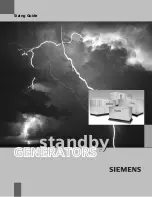
Generator Sizing Guide
Onsite Estimating Sheet
Generator Sizing Instructions:
There is not a single correct sizing solution. The instructions
below identify multiple methods that, when mixed with good
judgment, should result in a moderately sized generator.
Remember to consider load growth, seasonality, and effects
of starting motors.
When motors start, they create a current surge that step loads
the generator. As a result of this step loading, the generator
will experience a voltage dip. After selecting a generator,
reference the generator's surge capability using Table 3. Verify
that the generator voltage dip is adequate for the application.
Most commercial applications should be limited to 15%
voltage dip and residential applications should be limited to
30% voltage dip.
Some commercial applications utilize one or multiple
uninterruptible power supplies (UPS) to backup critical loads.
Please read sizing guidelines for this load type.
Measurement Method
Use a clamp-on amp meter or power analyzer to measure facil-
ity load levels. The measurement should be made at peak load
levels. Size the generator 25% larger than the peak measured
load. Verify motor and UPS load compatibility.
Measured Amps = _______
Billing History Method
Many commercial customers have a utility rate structure that
has a peak demand charge. Using a year's worth of electric
bills, size the generator 25% larger than the largest peak
demand. Verify motor and UPS load compatibility.
Peak Demand = _______
Load Summation Method
1) Enter all motors loads expected to run during peak load
levels into Table 6. Reference Table 1 for typical motor sizes
and electrical requirements.
2) Enter all non-motor loads expected to run during peak load
levels into Table 7. Reference Table 2 for typical residential
loads and rules of thumb.
3) Sum the running motor load data but do not include
the largest motor that is cycling. Add to this value the
non-motor load data and the starting kW for the largest
cycling motor.
Motor running load total
(minus largest cycling motor): ______ kW (Ref. Table 6)
Motor starting load from
largest cycling motor:
+ ______ kW (Ref. Table 6)
Non-motor load total:
+ ______ kW (Ref. Table 7)
Total (above items):
= ______ kW
Select generator (Total x 1.25) ______ kW
4) Verify voltage dip compatibility using generator Surge
Capability Table 3. Verify UPS compatibility using sizing
guidelines provided.
Initial Estimate and Cross Check Methods
These methods are for initial estimates and cross checks only.
Size the generator using one of the above methods.
Estimate based on 60% service size:
240 Volts, 1
Ø
: ________ amps x .15 = ________ kW
208 Volts, 3
Ø
: ________ amps x .22 = ________ kW
480 Volts, 3
Ø
: ________ amps x .50 = ________ kW
Estimate Based on Square Footage
Fast food, convenience stores, restaurants, grocery stores
= 50 kW + 10 watts / sq. ft.
Other commercial = 30 kW + 5 watts / sq. ft.
Square footage = ____________
Estimated kW = ____________
LP
LPG: 8.55 ft.
3
/lb., 4.24 lbs./gal.,
2500 btu/ft.
3
LPG: 36 ft.
3
= 1 gal.
Natural Gas
1 cubic foot = 1,000 BTUs
1 therm = 100,000 BTUs
Gas consumption = 13,000-16,000 btu
per kW/hr.
Pressure
1 inch mercury = 13.61 inches
Water Column
1 inch Water Column = 0.036 psi
5-14 inches water column = 0.18 psi
to 0.50 psi
Air Conditioning
1 hp per 1 ton
1 ton = 12,000 btu
Rule of Thumb
For 480 volt systems kW x 1.5 = Amps
For 208 volt systems kW x 3.5 = Amps
For 240 volt single phase systems
kW x 4 = Amps
9
Содержание Standby Generators
Страница 1: ...Sizing Guide standby GENERATORS ...
Страница 15: ...Notes ...


































